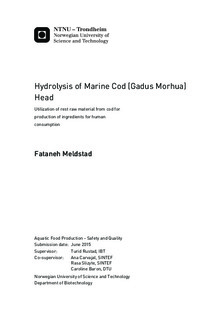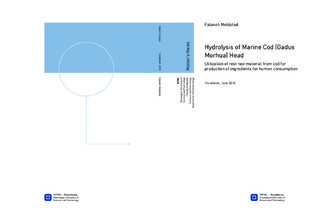| dc.description.abstract | The main objective of this study was to determine the possibility of utilizing
frozen marine cod head for further processing into high-quality and high-yield fish
protein hydrolysates. The project included determination of the effect of mincing
versus whole head, frozen storage and thawing methods on the composition and yield
of FPH.
The results show that freezing and thawing of cod head lead to small changes in
the composition of raw material and consequently the resulting fish protein
hydrolysate. The lipid content in freeze dried FPH ranged from 0.37-0.71% dryweight
for all samples, where the lowest belonged to the day one and the highest for
the whole head thawed in air. The protein content in freeze dried FPH was 88.4% for
day one and in the other samples, the concentration was more or less similar and
slightly lower than the day one sample (67.7-71.6%). While protein recovery was
5.7% dry weight for FPH produced from fresh cod head compared to 4.8 to 5.0% dry
weight for frozen samples.
The degree of hydrolysis showed variations among FPHs produced from different
raw materials and showed higher values for the whole head thawed in water and
minced head thawed in air and rather low for the day one sample. There was no
correlation between DH determined using formol titration and TCA-soluble peptides.
For example, there was a very high concentration of TCA-soluble peptides in day one
sample.
Regarding the yield of the dry matter in 60 min hydrolysed FPH factions; there is
a slight difference between the samples (10.6-12.3%), which makes it profitable to
produce FPH from frozen stored cod heads.
Economically speaking, it is more beneficial to store and thaw the minced head
using an appropriate thickness of packaging, because of the smaller space that is
required for the storage of the heads on board. In addition, if the right thickness and
size is used for packaging, the time that is needed to thaw them will be much shorter.
Due to small differences between the compositions of minced and whole head, it is
suggestible to store the samples in minced state.
Some optimizations are required for the hydrolysis process and analyses,
including using more appropriate fractionation, adjusting the time of thawing
according to the raw material to avoid excess changes during thawing and blending of
sediments prior to sampling for analysis.
Everything considered, in order to determine the suitability of the used processing
methods, and whether or not cod head can be used as raw material to produce high
quality FPH, there should be a clear definition of quality . For instance, it should be
determined in which section and for what purpose the end product is going to be
consumed. If we are looking for the functional properties of the FPH, there are
different characteristics that are required than when it is used for pharmaceutical
purposes. Therefore, different analysis methods should be used to determine the
changes in those particular required characteristics. | |

